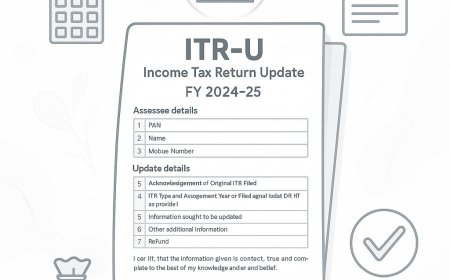ITR 3 Means in Income Tax: Everything You Need to Know
Discover the key updates in the ITR-3 form for FY 2024-25. Learn about new rules for capital gains, digital assets, unlisted shares, and more. Get tips for a smooth filing process and ensure you meet the deadline.

It’s that time of the year again—tax season is around the corner, and the Income Tax Department has introduced a few updates to the ITR-3 form for the Financial Year 2024–25. Whether you’re a self-employed professional, a business owner, or someone juggling capital gains and multiple properties, the ITR-3 is used for filing income tax returns in complex income situations.
What is the ITR-3 Form and Who Can File It?
The ITR-3 form is primarily meant for individuals and Hindu Undivided Families (HUFs) with income from a proprietary business or profession. So, who can file ITR-3? Here’s the list:
-
Individuals with income from a proprietary business or profession
-
Those earning capital gains from sources like stocks, mutual funds, and real estate
-
Taxpayers owning more than one property
-
Individuals holding foreign assets or offshore bank accounts
-
Investors with shares in unlisted companies
-
Partners in a firm not covered under presumptive income schemes
If your income sources are more complicated than just salary or interest, you probably need to file using ITR-3.
Key Updates in ITR-3 Form for FY 2024-25
Capital Gains Now Need to Be Split
Reporting capital gains accurately is crucial, especially when claiming capital gains exemption under various sections. For FY 2024-25, gains from selling stocks or mutual funds must be split into:
-
Gains from transactions before July 23, 2024
-
Gains from transactions after July 23, 2024
This aligns with the new flat 12.5% tax rate on certain long-term capital gains without indexation, providing more clarity on taxable gains.
Asset & Liability Reporting Threshold Raised
If your total income crosses ₹1 crore (up from ₹50 lakh earlier), you must disclose assets and liabilities in Schedule AL. This helps streamline compliance for taxpayers in higher income brackets.
Crypto & Digital Assets Get a Dedicated Section
Now, income from cryptocurrencies, NFTs, or other virtual digital assets must be reported separately in the ITR-3 form. Ensure all such transactions are documented to avoid future issues.
More Detailed Reporting for Unlisted Shares
To tighten regulation on unlisted investments, the form requires details such as the company’s PAN, purchase/sale transactions, and holding patterns.
Capital Losses from Share Buybacks Can Be Reported
Capital losses from share buybacks (on or after October 1, 2024) can now be claimed, but only if the related income is declared under “Income from Other Sources.”
New Presumptive Taxation for Cruise Business
The ITR-3 form now includes Section 44BBC for income from operating cruise ships, introduced in Budget 2024.
Old Tax Regime Deductions and Tax Slabs: What You Should Know
With the new tax regime as default, taxpayers can still opt for the old tax regime deductions such as Section 80C (investments), House Rent Allowance (HRA), medical insurance, and others. However, once you choose the old regime, you must file Form 10-IEA before the deadline to stick with it for the year.
The old tax regime tax slabs still apply to those who opt for it, providing various slabs and exemptions based on income levels, which might be beneficial if you have many deductions.
Filing Deadline and Tips
The deadline to file ITR-3 for FY 2024-25 (Assessment Year 2025-26) is July 31, 2025, unless your accounts require an audit. Missing the deadline can attract penalties, so timely filing is important.
Pro Tips:
-
Keep your capital gains and deduction documents ready
-
Evaluate benefits under both tax regimes before filing
-
Use official or trusted portals
-
Consult a tax professional if your income is complex
Conclusion
The ITR-3 form plays a vital role for taxpayers with complex income sources, helping ensure accurate reporting of business income, capital gains, and digital assets. Understanding what ITR 3 is used for and knowing ITR 3 who can file will help you decide if this form suits your tax filing needs.
Also, choosing between the new tax regime and the old tax regime deductions and understanding the old tax regime tax slabs can significantly impact your tax liability. Don’t forget to check if you qualify for any capital gains exemption while filing.
Start early, keep your documents in order, and file smart with the right knowledge!
What's Your Reaction?
 Like
0
Like
0
 Dislike
0
Dislike
0
 Love
0
Love
0
 Funny
0
Funny
0
 Angry
0
Angry
0
 Sad
0
Sad
0
 Wow
0
Wow
0



























































































